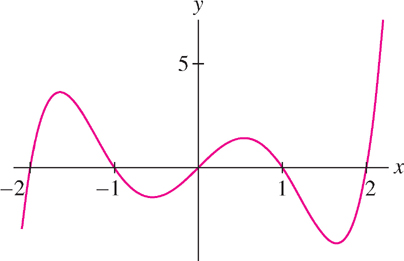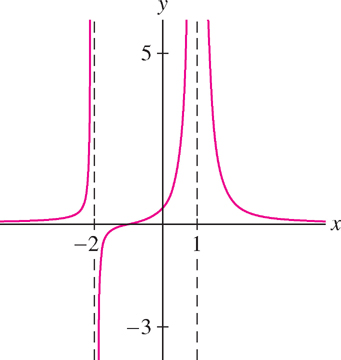1.3 The Basic Classes of Functions
It would be impossible (and useless) to describe all possible functions \(f(x)\). Since the values of a function can be assigned arbitrarily, a function chosen at random would likely be so complicated that we could neither graph it nor describe it in any reasonable way. However, calculus makes no attempt to deal with all functions. The techniques of calculus, powerful and general as they are, apply only to functions that are sufficiently “well-behaved” (we will see what well-behaved means when we study the derivative in Chapter 3). Fortunately, such functions are adequate for a vast range of applications.
Most of the functions considered in this text are constructed from the following familiar classes of well-behaved functions:
polynomialsrational functionsalgebraic functions
exponential functionstrigonometric functions
logarithmic functionsinverse trigonometric functions
We shall refer to these as the basic functions.
- Polynomials: For any real number \(m\), \(f(x) = x^{m}\) is called the power function with exponent \(m\). A polynomial is a sum of multiples of power functions with whole-number exponents (Figure 1.36):
\[ f(x) = x^{5} - 5x^{3} + 4x,\quad g(t) = 7t^{6} + t^{3} - 3t - 1 \]

Thus, the function \(f(x) = x + x^{-1}\) is not a polynomial because it includes a power function \(x^{-1}\) with a negative exponent. The general polynomial in the variable \(x\) may be written
\[ P(x) = a_nx^n + a_{n-1}x^{n-1}+\cdots+a_1x+a_0 \]
- – The numbers \(a_{0}, a_{1},\ldots,a_{n}\) are called coefficients.
- – The degree of \(P(x)\) is \(n\) (assuming that \(a_{n} \neq 0\)).
- – The coefficient \(a_{n}\) is called the leading coefficient.
- – The domain of \(P(x)\) is \(\mathbb{R}\).
- A rational function is a quotient of two polynomials (Figure 1.37):
\[ f(x) = \frac{P(x)}{Q(x)}\quad\text{[\(P(x)\) and \(Q(x)\) are polynomials]} \]

22
The domain of \(f(x)\) is the set of numbers \(x\) such that \(Q(x) \neq 0\). For example,
\begin{align*} f(x)&=\frac{1}{x^2} &&\text{domain }\{x:x\neq0\}\\ h(t)&=\frac{7t^6+t^3-3t-1}{t^2-1} &&\text{domain }\{t:t\neq\pm1\} \end{align*}
Every polynomial is also a rational function [with \(Q(x) = 1\)].
- An algebraic function is produced by taking sums, products, and quotients of roots of polynomials and rational functions (Figure 1.38):
\[ f(x) = \sqrt{1+3x^2-x^4},\quad g(t) = \left(\sqrt{t} - 2\right)^{-2},\quad h(z)=\frac{z + z^{-5/3}}{5z^3-\sqrt{z}} \]

Any function that is not algebraic is called transcendental. Exponential and trigonometric functions are examples, as are the Bessel and gamma functions that appear in engineering and statistics. The term “transcendental” goes back to the 1670s, when it was used by Gottfried Wilhelm Leibniz (1646–1716) to describe functions of this type.
A number \(x\) belongs to the domain of \(f\) if each term in the formula is defined and the result does not involve division by zero. For example, \(g(t)\) is defined if \(t \geq 0\) and \(\sqrt{t}\neq 2\), so the domain of \(g(t)\) is \(D = \{t : t \geq 0 and t \neq 4\}\). More generally, algebraic functions are defined by polynomial equations between \(x\) and \(y\). In this case, we say that \(y\) is implicitly defined as a function of \(x\). For example, the equation \(y^{4} + 2x^{2}y + x^{4} = 1\) defines \(y\) implicitly as a function of \(x\).
- Exponential functions: The function \(f(x) = b^{x}\), where \(b > 0\), is called the exponential function with base \(b.\) Some examples are
\[ f(x)=2^x,\quad g(t)=10^t,\quad h(x)=\left(\frac{1}{3}\right)^x,\quad p(t)=\left(\sqrt{5}\right)^t \]
Exponential functions and their inverses, the logarithmic functions, are treated in greater detail in Section 1.6.
- Trigonometric functions are functions built from \(\sin x\) and \(\cos x\). These functions and their inverses are discussed in the next two sections.
1.3.1 Constructing New Functions
Given functions \(f\) and \(g\), we can construct new functions by forming the sum, difference, product, and quotient functions:
\begin{align*} (f+g)(x)&=f(x)+g(x),&(f-g)(x)&=f(x)-g(x)\\ (fg)(x)&=f(x)g(x),&\left(\frac{f}{g}\right)(x)&=\frac{f(x)}{g(x)}\quad\text{(where \(g(x)\neq 0\))} \end{align*}
For example, if \(f(x) = x^{2}\) and \(g(x) =\sin x\), then
\begin{align*} (f+g)(x)&=x^2+\sin x,& (f-g)(x)&=x^2-\sin x\\ (fg)(x)&=x^2\sin x,& \left(\frac{f}{g}\right)(x)&=\frac{x^2}{\sin x} \end{align*}
We can also multiply functions by constants. A function of the form
\[ c_{1}f(x) + c_{2}g(x) \quad\text{(\(c_{1}, c_{2}\) constants)} \]
is called a linear combination of \(f(x)\) and \(g(x)\).
23
Composition is another important way of constructing new functions. The composition of \(f \) and \(g\) is the function \(f \circ g\) defined by \((f \circ g)(x) = f(g(x))\). The domain of \(f \circ g\) is the set of values of \(x\) in the domain of \(g\) such that \(g (x)\) lies in the domain of \(f\).
EXAMPLE 1
Compute the composite functions \(f \circ g\) and \(g \circ f\) and discuss their domains, where
\[ f(x)=\sqrt{x},\quad g(x)=1-x \]
Example 1 shows that the composition of functions is not commutative: The functions \(f \circ g\) and \(g \circ f\) may be (and usually are) different.
Solution We have
\[ (f\circ g)(x)=f(g(x))=f(1-x)=\sqrt{1-x} \]
The square root \(\sqrt{1-x}\) is defined if \(1 - x \geq 0\) or \(x \leq 1\), so the domain of \(f \circ g\) is \(\{x : x \leq 1\}\). On the other hand,
\[ (g\circ f)(x)=g(f(x))=g\left(\sqrt{x}\right)=1-\sqrt{x} \]
The domain of \(g \circ f\) is \(\{x : x \geq 0\}\).
1.3.2 Elementary Functions
Inverse functions are discussed in Section 1.5.
As noted above, we can produce new functions by applying the operations of addition, subtraction, multiplication, division, and composition. It is convenient to refer to a function constructed in this way from the basic functions listed above as an elementary function. The following functions are elementary:
\[ f(x) = \sqrt{2x+\sin x},\quad f(x)=10^{\sqrt{x}},\quad f(x)=\frac{1+x^{-1}}{1+\cos x} \]
1.3.3 Section 1.3 Summary
- For \(m\) a real number, \(f(x) = x^{m}\) is called the power function with exponent \(m\). A polynomial \(P(x)\) is a sum of multiples of power functions \(x^{m}\), where \(m\) is a whole number:
\[ P(x) = a_nx_n+a_{n-1}x^{n-1}+\cdots+a_1x+a_0 \]
This polynomial has degree \(n\) (assuming that \(a_{n} \neq 0\)) and \(a_{n}\) is called the leading coefficient.
- A rational function is a quotient \(\frac{P(x)}{Q(x)}\) of two polynomials.
- An algebraic function is produced by taking sums, products, and \(n^{\text{th}}\) roots of polynomials and rational functions.
- Exponential function: \(f(x) = b^{x}\), where \(b > 0\) (\(b\) is called the base).
- The composite function \(f \circ g\) is defined by \((f \circ g)(x) = f(g(x))\). The domain of \(f \circ g\) is the set of \(x\) in the domain of \(g\) such that \(g(x)\) belongs to the domain of \(f\).